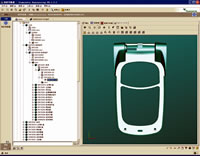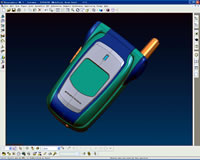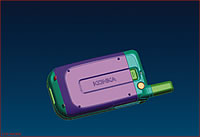Konka leverages PLM to build momentum for new product development and introduction
A managed development environment supports Konka's bid to become China's leading mobile phone producer.Konka's goal is to create such innovative mobile phones that it overtakes foreign competition and becomes the leading domestic supplier in China.
Aiming for the top
Companies from all over the world want a piece of the Chinese mobile phone market. Local manufacturer, Konka Telecommunications, has a big slice now, but its goal is to go from its current rank as the thirdplace domestic supplier to number one. As part of that goal, management targeted certain inefficiencies in the new product development and introduction (NPDI) process for improvement. For example, they wanted to enhance collaboration among members of product teams and improve their access to product information. They also wanted better management of product data to ensure its accuracy, safety and authorization control.
Konka's previous data management system used a complicated authorization scheme that led to errors. It took a long time to archive data, required a lot of space and was not easy to search. Another requirement was better control and visibility of projects in progress. "As for our previous product development process, it was difficult to be aware of progress and the work status of engineers at any time," says Zheng Jianhang, Konka Telecommunications' leader. "We required many meetings for communication."
To address these challenges, Konka Telecommunications implemented a managed development environment based on UGS solutions, NX? and Teamcenter?. The company chose to partner with UGS in this effort because it had confidence in UGS as the world's leading supplier of PLM solutions. Other factors that led to the selection of UGS were the development potential of the company, the availability of an expert implementation team and the strong technical functionality of UGS solutions.


Creating the managed development environment
Internal and external implementation teams worked together to create the managed development environment. The internal team consisted of the project supervision committee, the project manager, project implementation staff and project support staff. The external team consisted of UGS experts as well as in-house members of the project supervision committee and the project manager. Using UGS technology, these teams established a standard and streamlined process for product design; created an integrated platform for collaborative work; set up a system of documentation control with a central database containing all product data; and codified best practices in two applications, "Working in Process" and "Working in Project." They proved their concept in a pilot program that simulated the development of a mobile phone. At completion of the pilot, Konka Telecommunications implemented the technology company-wide.
Using and benefiting from the improved environment
From the top down, Konka Telecommunications is realizing the advantages of the managed development environment. Mr. Zheng comments, "The product development process is now more transparent and the number of my meetings is down by 30 percent."
For Yu Linchu, the main designer of mobile phone structures, the enhanced level of project transparency is also an important benefit. "In this collaborative design environment, you can be aware of design progress at any time. The whole project is well under control," he says.
Lin Nengqing, a mobile phone structure designer, appreciates the efficiency that is resulting from improved collaboration. "Now with the collaborative design process, I can be aware of structural changes caused by other components, saving 10 to 20 percent of my time," he says. Another mobile phone structure designer, Hu Jiaying, appreciates how design standards are enforced. "The design standards of the company are managed by the system, which can be queried at any time during the product design process," she explains. "Also, a company-wide standard components database has been established. Revision times are reduced and design quality can be ensured."
Hu Gong, the company's documentation controller sees numerous benefits as well. "Under the managed development environment, document authorization is automated, leading to a 90 percent decrease in workload and errors, a 45 percent reduction in data redundancy and a 30 percent reduction in data search time by designers," he explains. Overall, Konka Telecommunications' goals going into the implementation have been fully realized, according to Liu Weijun, information director at Konka Telecommunications. He attributes this to clear communication between his company and UGS before, during and after the implementation. Some unexpected benefits were also realized. The new environment has improved the division of work, resulting in improved product quality and innovation.











